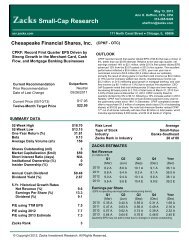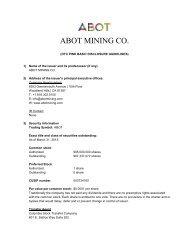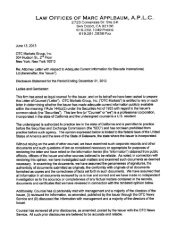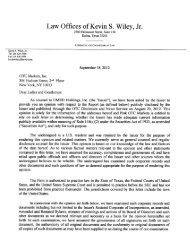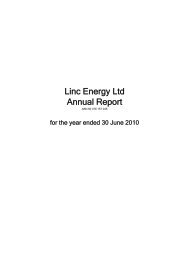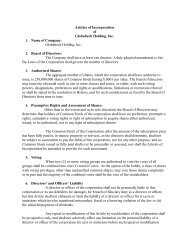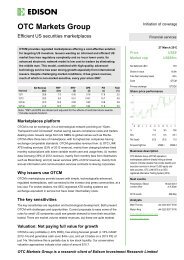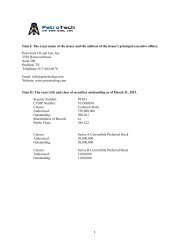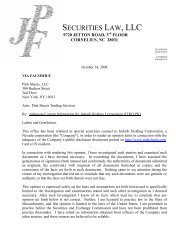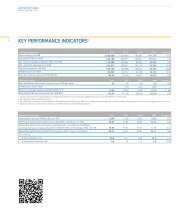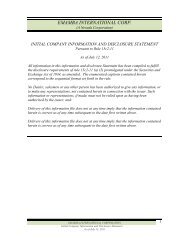2013 Apr 15 Annual Report 2012 - Phosphagenics
2013 Apr 15 Annual Report 2012 - Phosphagenics
2013 Apr 15 Annual Report 2012 - Phosphagenics
You also want an ePaper? Increase the reach of your titles
YUMPU automatically turns print PDFs into web optimized ePapers that Google loves.
The <strong>Phosphagenics</strong><br />
Evolution<br />
THE STORY SO FAR… YEAR BY YEAR<br />
<strong>Phosphagenics</strong> genesis finds its origin in a share<br />
placement done in June 1999 by Greenchip<br />
Development Ltd to raise money to buy a number<br />
of different technologies. The owners of those<br />
technologies were to a large extent associated<br />
with the inventor Simon West. They had had some<br />
success previously commercialising a technology<br />
to extract Beta Caratene from Algae which was<br />
purchased by US giant Henkel and became the<br />
largest natural Beta Caratene producer in the<br />
world. Harry Rosen, who was at the time the<br />
director of Betatene, became the vice president,<br />
Corporate Development at Henkel. This group of<br />
investors and entrepreneurs had shown the ability<br />
to take a theoretical idea to a commercial reality.<br />
Greenchip Development which was a pooled<br />
development fund ( which provided certain tax<br />
advantages), changed its name to Vital Capital<br />
whose major assets were partial holdings in a<br />
suite of technologies. In 1999 they announced<br />
that they had a water soluble form of Vitamin<br />
E which would have some significance in the<br />
health drink and supplement industries. Part of<br />
the technology was a process to extract Vitamin<br />
E from Palm oil and a pilot plant was built in<br />
Malaysia to conduct trials.<br />
In 2000 Vital Capital merged with Greenchip<br />
Emerging Growth, whose main asset was cash.<br />
Ironically at this stage, and for the next two years<br />
the Vitamin E project saw very little in the way of<br />
development, as other programs seemed closer<br />
to commercialisation.<br />
In 2002 the first announcement of the improved<br />
dermal delivery of oestradoil was made. A number<br />
of other candidates were chosen with Atropine<br />
and Testosterone being successfully delivered,as<br />
well using the Vitamin E Phosphate technology.<br />
In 2003 Vital Capital completed its first<br />
commercial deal, the supply of Vital ET ® to ISP<br />
for use in the personal care market. ISP had<br />
conducted extensive tests that the Vital Capital<br />
form of vitamin E provided superior delivery to<br />
other forms. This commercial relationship remains<br />
in place today ten years later.<br />
Vital Capital announced success in delivery<br />
of Morphine transdermally a few months later.<br />
Research was also dedicated to showing that<br />
Vitamin E Phosphate had a significant number<br />
of heart health benefits. On the back of this<br />
research the Company was able to negotiate<br />
a successful deal with a US company Zila for<br />
the sale of its product as a dietary supplement.<br />
Whilst the total Vitamin E market was impacted<br />
by negative press around that time, this contract<br />
gave Vital Capital and later <strong>Phosphagenics</strong><br />
a revenue stream for several years.<br />
In 2004 trials were started on a heart drug<br />
APA01 which showed encouraging results in<br />
animals, and preliminary moves were made for<br />
the development of a Morphine patch. Ester E<br />
(Zila’s product) was on sale in the US and a<br />
material transfer agreement was made with ALZA<br />
corporation a subsidiary of Johnson & Johnson<br />
to investigate the <strong>Phosphagenics</strong> delivery system.<br />
07<br />
THE PHOSPHAGENCIS EVOLUTION



